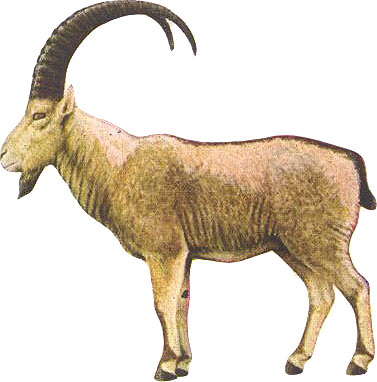|
|
Ibex
: Capra ibex
Ladakh:
Skin or Sakin (male), Dabmo or Danmo (female); Kulu: Tangrol
The
male ibex also has a beard, usually black, and a strong goatish
smell. Like the ammon and bharal, the ibex is also stoically
built, with a height of 100cms at the shoulder and weighing
about 90 kgs. The color is generally brown, with shades varying
from deep chocolate to dirty cream. In summer some of them acquire
a reddish hue. A deep dark line extends from the neck to the
tail. The legs too are dark brown while the belly is whitish.
The ibex also grows a very fine and soft fleece under its stiff
hairy coat and this insulates the animal against the winters
cold. In summer when it begins coming off in patches, the ibex
presents a ragged appearance. This wool called pashm (or kel
phamb in Kashmiri) is highly prized for its warmth and softness
and goes to make some of the loveliest shawls and stoles of
Kashmir.

The stately scimitar horns of the male invest the animal with
dignity. The horns are heavily notched, the knot believed to
be indicative of the animals age. A well-grown ram has horns
from 100 to 115 Cms in length. The greatest record length is
147.3 cm. The females are smaller and have only small horns.
The animals beard is long and pointed and grows under the chin.
The ibex are found in the mountains of Ladakh and Baltistan,
especially in the latter territory where they used to be numerous.
They frequent the most inaccessible places, usually cliffs,
during daytime in summer and come down only for grazing. But
they are very cautious and before descending, put an older buck
on sentry duty on a prominent rock. His work is to alarm the
whole herd as soon as he sights or suspect the danger.
The ibex too have well-developed powers of sight, hearing and
smell. But in winter when they sometimes come down to lower
grazing grounds because the higher ones are under snow they
are exposed to great danger especially as they have the habit
of staying in the same place for days together. They however
come down in the evening to take the advantage of poor light.
Some good ibex are found in Zanaskar, which receives much snow.
As a matter of fact the Ibex do not mind the snow and are occasionally
found on ground that is deep in snow.
The ladakhis appear to have been fond of the Ibex from remote
antiquity. This is indicated by ancient drawings of the animal
on rocks and inside caves. The animal is mentioned in some of
their songs.
In recent years the Ibex has been brought to the verge of extinction
as the animal has been killed not only for his excellent wool
but also for his meat, which considered as delicacy.
|


